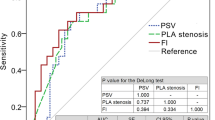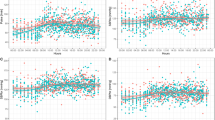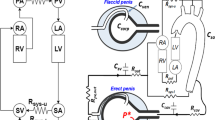Abstract
Recently it has been reported that there is a strict correlation between erectile dysfunction (ED) and cardiovascular diseases, but the importance of such relationship still needs to be addressed. Ultrasonographic peak systolic velocity (PSV), is considered a reliable parameter for the diagnosis of arteriogenic ED. However, the cut-off value of PSV<30 cm/s has sufficient sensitivity only in the diagnosis of advanced arteriogenic ED and it is not representative of peripheral vascular alterations. In the present study, we set up an age-adjustment of PSV – calculated with the formula PSV <6.73+age × 0.7 – that permits a more accurate diagnosis of vascular aetiology in ED patients and may predict the presence of carotid wall alterations. We studied 179 consecutive subjects (mean age 52 years, range 23–79 years), with a history of ED of at least 6 months, by means of penile colour doppler ultrasonography (P-CDU) and common carotid arteries colour doppler ultrasonography (CCA-CDU) between June 2003 and September 2004. Statistical analysis was carried out with the statistical software R. PSV and CCAD values showed a statistically significant negative correlation. Age adjustment further improved this relationship permitting to identify an age-dependent PSV cut-off given by the formula PSV <6.73+age × 0.7. The age-adjusted PSV cut-off allows an accurate interpretation of vascular aetiology in ED patients and predicts the presence of carotid wall alterations, from the intima-media pathologic thickness to the plaque formation, with high values of both sensitivity and specificity.
This is a preview of subscription content, access via your institution
Access options
Subscribe to this journal
Receive 8 print issues and online access
$259.00 per year
only $32.38 per issue
Buy this article
- Purchase on Springer Link
- Instant access to full article PDF
Prices may be subject to local taxes which are calculated during checkout





Similar content being viewed by others
References
Feldman HA, Goldstein I, Hatzichkristou DG, Krane RJ, McKinlay JB . Impotence and its medical and psychosocial correlates: results of the Massachusetts Male Aging Study. J Urol 1994; 151: 54–61.
Kloner RA, Speakman M . Erectile dysfunction and atherosclerosis. Curr Atheroscler Rep 2002; 4: 397–401.
Montorsi F, Briganti A, Salonia A, Rigatti P, Margonato A, Macchi A et al. Erectile dysfunction prevalence, time of onset and association with risk factors in 300 consecutive patients with acute chest pain and angiographically documented coronary artery disease. Eur Urol 2003; 44: 360–365.
Soo Woong Kim . Potential predictors of asymptomatic ischemic heart disease in patients with vasculogenic erectile dysfunction. Urol 2001; 58(3): 441–445.
Kawanishi Y, Sogou T . Screening of ischemic heart disease with cavernous artery blood flow in erectile dysfunction patients. Int J Impot Res 2001; 13(2): 100–103.
Juonala M, Viikari J, Laitinen T, Marniemi J, Helenius H, Ronnemaa T et al. Interrelations between brachial endothelial function and carotid intima-media thickness in young adults. Circulation 2004; 110: 2918–2923.
O'Leary DH, Polak JF, Kronmal RA, Manolio TA, Burke GL, Wolfson SK . Carotid-artery intima and media thickness as a risk factor for myocardial infarction and stroke in older adults. N Engl J Med 1999; 340: 14–22.
Poli A, Tremoli L, Colombo A, Sintori M, Pignoli P, Paoletti R . Ultrasonographic measurement of the common carotid artery wall thickness in hypercholesterolemic patients: a new for the quantitation and follow-up of preclinical atherosclerosis in living subjects. Atherosclerosis 1988; 20: 253.
Pagani E, Puech-Leao P, Glina S, Reis JM . The value of a second injection on the pharmacoinduced erection test. Int J Impot Res 1997; 9: 167–168.
Hastie T, Tibshirani R, Friedman J . The Elements of Statistical Learning. Data Mining, Inference and Prediction. Springer-Verlag: New York, 2001, Chapter 4.
Benson C, Aruny J, Vickers M . Correlation of duplex sonography with arteriography in patients with erectile dysfunction. Am J Roentgenol 1993; 160(1): 71–73.
Ferrini G, Darila H, Valente E, Gonzalez-Cadavid N, Rajfer J . Aging-related induction of inducible nitric oxide synthase is vasculo-protective to the arterial media. Cardiovascular Res 2004; 61(4): 796–805.
Author information
Authors and Affiliations
Corresponding author
Rights and permissions
About this article
Cite this article
Caretta, N., Palego, P., Roverato, A. et al. Age-matched cavernous peak systolic velocity: a highly sensitive parameter in the diagnosis of arteriogenic erectile dysfunction. Int J Impot Res 18, 306–310 (2006). https://doi.org/10.1038/sj.ijir.3901413
Received:
Revised:
Accepted:
Published:
Issue Date:
DOI: https://doi.org/10.1038/sj.ijir.3901413
Keywords
This article is cited by
-
The flow index provides a comprehensive assessment of erectile dysfunction by combining blood flow velocity and vascular diameter
Scientific Reports (2022)
-
Significant Improvement of Erectile Function after Roux-en-Y Gastric Bypass Surgery in Obese Chinese Men with Erectile Dysfunction
Obesity Surgery (2015)



